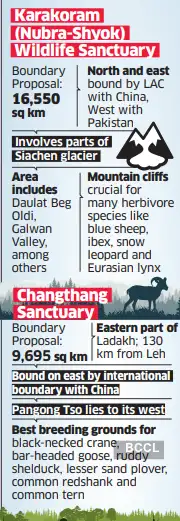It was proposed by the Ladakh State Wildlife Board at its September 19 assembly that the Karakoram wildlife sanctuary's new revised space ought to stand at 16,550 sq km whereas Changthang's at 9, 695 sq km.
This ‘rectification' is way greater than the close to 5,000 sq km and 4,000 sq km notified, respectively, for the 2 sanctuaries in 1987.

The brand new boundaries, nevertheless, will contain exclusion of 1,742 sq km from the Karakoram (Nubra-Shyok) WLS and one other 164 sq km from the high-altitude chilly desert WLS in Changthang, ET has learnt.
In case of the Karakoram sanctuary, the excluded zone will run alongside the Nubra-Shyok rivers in a linear trend because the habitation is so situated within the space. In case of Changthang, the excluded space can be in pockets round human habitation. Each areas have been declared wildlife sanctuaries via a authorities notification in 1987.
Nevertheless, practically 4 many years later it's felt that the 1987 notification didn't represent a correctly outlined space and that there's a mismatch within the description of North-South-East-West boundaries. The precise space was mentioned to be 3-4 occasions bigger than what was notified in 1987.The ‘rationalisation' of the 2 sanctuaries has, accordingly, been proposed after an in depth research by the Wildlife Institute of India (WII) and discussions with native stakeholders and the administration.WII, it's learnt, has recognized Excessive Conservation Worth Areas (HCVAs) in each the protected areas (on the premise of six parameters) which needs to be given highest ranges of safety and appreciable restriction in actions. 10 HCVAs have been recognized in Karakoram sanctuary and 17 in Changthang sanctuary, with wildlife corridors spanning 9 sq km within the former.
It's, nevertheless, the excluded space together with 67 and 45 villages within the two sanctuaries respectively, that's key to unlocking financial exercise and tourism potential within the Himalayan area, it's argued.
Deliberations held on the thirteenth assembly of the Ladakh State Board of Wildlife on September 19 famous that the main target was not on creating “massive business ventures” however on facilitating folks residing inside the sanctuaries.
A lot of them have been closely depending on tourism for his or her livelihood however have been unable to develop even native tourism-linked small-scale infrastructure like homestays and visitor homes as a result of Wildlife Act, it was shared at a gathering by Ladakh chief secretary Pawan Kotwal. Looking for permissions was usually a ‘lengthy and time consuming course of' and therefore a deterrent for the inhabitants.
Tashi Gyalson, Chief Government Councillor, Leh Ladakh Autonomous Hill Growth Council, mentioned delays in offering important companies comparable to electrical energy, ingesting water, street connectivity, and so forth was discouraging folks from persevering with to stay in distant areas. This was resulting in a worrying ‘depopulation of border villages'.
Gyalson identified that the continued presence of villagers in border areas could be crucial for ‘sustaining vigilance and securing our worldwide borders'. This can be a essential concern as the 2 sanctuaries are very important to India's strategic pursuits.









